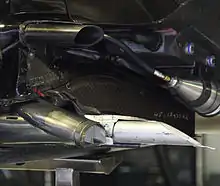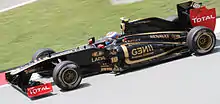Renault R31
The Renault R31 was a Formula One racing car designed by Lotus Renault GP for the 2011 Formula One season. The chassis was designed by James Allison, Naoki Tokunaga, Tim Densham and Dirk de Beer with Rob White leading the engine design. The car's distinctive black and gold livery was designed as a tribute to the Team Lotus cars of the 1980s and the famous John Player Special liveries (those cars also used Renault engines). Speculation suggested that as the design is reminiscent of a cigarette package, the team would be in violation of strict anti-tobacco laws in Canada and would be unable to use it at the 2011 Canadian Grand Prix. However, senior team personnel dismissed the claims,[2] stating that "another famous team" was racing with colours similar to those of another tobacco brand and had done so in Canada without trouble in previous years. Ultimately, the car raced in Canada with no changes to its livery.
 | |||||||||||
| Category | Formula One | ||||||||||
|---|---|---|---|---|---|---|---|---|---|---|---|
| Constructor | Renault | ||||||||||
| Designer(s) | James Allison (Technical Director) Naoki Tokunaga (Deputy Technical Director) Tim Densham (Chief Designer) Dirk de Beer (Head of Aerodynamics) | ||||||||||
| Predecessor | Renault R30 | ||||||||||
| Successor | Lotus E20 - Lotus Engineering Renault RS16 - Renault branded | ||||||||||
| Technical specifications[1] | |||||||||||
| Chassis | Moulded carbon fibre and aluminium honeycomb composite monocoque, with engine incorporated as a fully stressed member | ||||||||||
| Suspension (front) | Carbon fibre double wishbone, operating inboard torsion bar and damper units via a pushrod system | ||||||||||
| Suspension (rear) | As front except via a pullrod system | ||||||||||
| Engine | Renault RS27-2011 2,400 cc (146.5 cu in) 90° V8, limited to 18,000 RPM with KERS naturally aspirated mid-mounted | ||||||||||
| Transmission | Seven-speed semi-automatic titanium gearbox with reverse gear "Quickshift" system | ||||||||||
| Weight | 640 kg (1,411 lb) (including driver) | ||||||||||
| Fuel | Total | ||||||||||
| Tyres | Pirelli P Zero OZ Wheels (front and rear): 13" | ||||||||||
| Competition history | |||||||||||
| Notable entrants | Lotus Renault GP | ||||||||||
| Notable drivers | 9. 9. 10. | ||||||||||
| Debut | 2011 Australian Grand Prix | ||||||||||
| |||||||||||
Design


The R31 was unveiled at the Circuit Ricardo Tormo in Valencia, Spain on 31 January 2011,[3] where Vitaly Petrov was first to drive it.[4] Renault had planned to have Robert Kubica as teammate to Petrov, but Kubica got injured while testing a rally car. So, Renault hired Kubica's former BMW Sauber teammate Nick Heidfeld instead. The car attracted attention for a radical exhaust system, with speculation suggesting that it could be routed under the floor to create a "forward blown diffuser" effect after the car was unveiled with no visible exhaust vents, though Renault did not confirm nor deny any technical developments except to state that the car had been the product of a twelve-month development cycle.[5] It was suggested[6] that several other teams were been quick to adapt to the concept, with talk that the forward blown diffuser would be implemented on several cars for upcoming tests. It had been further implied[7] that the exhaust system offered significant gains, as incorporating them is a complex process, requiring teams to rearrange the internal electronics of the car and undertaking strenuous side-impact tests to get the new parts approved. However, some key personnel from other teams – most notably Mercedes' Ross Brawn – downplayed the importance of the parts.[8] The exhaust system became a major disadvantage as the season unfolded. The car suffered from low downforce on slower circuits, particularly Singapore. The system also made it extremely difficult to develop the car. After the Abu Dhabi Grand Prix, designer James Allison admitted the forward exhaust concept rendered the R31 a 'failed experiment':
"The layout which had promised so much, and which, had it delivered, would have been almost impossible to copy, proved very tricky to develop and had a fundamental weakness in slow corners that has been an albatross around our neck all year. [9]
Martin Brundle described the forward-facing exhaust as "sounding like a bag of nails." However David Coulthard disproved this theory by buying a bag of nails.[10]
Season review
It was a solid début for the R31 with Vitaly Petrov qualifying sixth and then taking his first F1 podium in the opening round of 2011 in Melbourne. This was followed by an equal qualifying and race result for Nick Heidfeld in the Malaysian Grand Prix while teammate Petrov was launched in the air by a high kerb with a few laps remaining. This was to be the last of Renault's podiums though, and they remained fourth in the Constructors' Championship after Petrov's ninth in China and their first double points score in Turkey with seventh and eighth. Heidfeld's fire in Saturday Practice meant the car was badly damaged in the Spanish Grand Prix, and he had to start in twenty-fourth. The R31 was repaired by Sunday though, and Heidfeld charged to the points (eighth) and pushed teammate Petrov out of them (eleventh) in the process.

In Monaco Petrov crashed out from sixth place with 6 laps to go, knocking himself unconscious temporarily, and causing a red flag. Heidfeld still collected valuable points though, finishing in eighth again. In a wet Canadian Grand Prix, it was Heidfeld's turn to crash, this time from fourth; Petrov however, still took fifth by the end of the race. Heidfeld took points in both Valencia and Britain to keep them ahead of Mercedes for as long as possible, before they ended up fifth after the Silverstone race. Two retirements for Heidfeld followed in his final two races for the team in Germany and Hungary, both causing significant damage to the R31. With only a ninth in Germany for Petrov, at the team's first no score of the season in Hungary it was obvious development of the R31 was not fast enough and they were slipping backwards.

After the summer break, the car seemed to have rediscovered form in qualifying; with Heidfeld's replacement Bruno Senna qualifying seventh in mixed weather in Spa and Petrov tenth - and the pair the opposite way around in Monza. Unfortunately, the same could not be said for these races, with only two ninth places (and Senna's first points) from the pair of them. Things seemed dreadful for them in the Singapore Grand Prix, a track that definitely did not suit the car, because Petrov was knocked out in Q1 and Senna was only fifteenth in qualifying. Senna did not improve his position in the race, and Petrov moved up one place. This meant the team were struggling even to maintain their fifth place in the Constructors' Championship - sixth placed Force India had scored 36 points in the last four Grands Prix to Renault's 4, and were now only 22 points behind. Both Senna and Petrov returned to the top ten in qualifying in the Japanese Grand Prix, and after a close race with many other cars for the tail end of the points, Petrov eventually took ninth with Senna down in nineteenth. Three disappointing races followed in Korea, India and Abu Dhabi, where neither driver scored a point. Petrov finished tenth to score one point at the R31's final race, and 2011 season finale at the Brazilian Grand Prix. Senna failed to score points by finishing in seventeenth, yet Renault remained fifth in the Constructors' Championship standings with a best result of third place, albeit being 95 points behind Mercedes.
Complete Formula One results
(key) (results in bold indicate pole position; results in italics indicate fastest lap)
| Year | Entrant | Engine | Tyres | Drivers | 1 | 2 | 3 | 4 | 5 | 6 | 7 | 8 | 9 | 10 | 11 | 12 | 13 | 14 | 15 | 16 | 17 | 18 | 19 | Points | WCC |
|---|---|---|---|---|---|---|---|---|---|---|---|---|---|---|---|---|---|---|---|---|---|---|---|---|---|
| 2011 | Lotus Renault GP | Renault RS27 V8 | P | AUS | MAL | CHN | TUR | ESP | MON | CAN | EUR | GBR | GER | HUN | BEL | ITA | SIN | JPN | KOR | IND | ABU | BRA | 73 | 5th | |
| Nick Heidfeld | 12 | 3 | 12 | 7 | 8 | 8 | Ret | 10 | 8 | Ret | Ret | ||||||||||||||
| Bruno Senna | 13 | 9 | 15 | 16 | 13 | 12 | 16 | 17 | |||||||||||||||||
| Vitaly Petrov | 3 | 17 † | 9 | 8 | 11 | Ret | 5 | 15 | 12 | 10 | 12 | 9 | Ret | 17 | 9 | Ret | 11 | 13 | 10 |
† Driver failed to finish the race, but was classified as they had completed >90% of the race distance.
References
- "Lotus Renault GP R31: Technical Specifications". lotusrenaultgp.com. Lotus Renault GP. 31 January 2011. Retrieved 5 February 2011.
- Collantine, Keith (2011-01-31). "Lopez has no concerns over tobacco branding". F1 Fanatic. Keith Collantine. Retrieved 2011-02-01.
- "Renault to unveil R31 ahead of first test". Formula1.com. Formula One Administration. 6 January 2011. Retrieved 6 January 2011.
- Noble, Jonathan (2011-01-25). "Petrov first to test new Renault". Autosport.com. Haymarket Publications. Retrieved 2011-01-26.
- Noble, Jonathan (2011-01-31). "Renault: Long development time a boost". Autosport.com. Haymarket Publications. Retrieved 2011-02-01.
- Jonathan Noble; Dieter Rencken (2011-02-01). "Renault confident in radical exhaust". Autosport.com. Haymarket Publications. Retrieved 2011-02-03.
- Allen, James (2011-02-02). "Valencia Test: Day 2 – Ferrari and Alonso step up". James Allen on F1. James Allen. Retrieved 2011-02-03.
- Noble, Jonathan (2011-02-02). "Brawn: Forward exhausts not essential". Autosport.com. Haymarket Publications. Retrieved 2011-02-03.
- "Renault admits its 2011 car and exhaust concept was a 'bold failure'". Autosport. November 19, 2011. Retrieved November 26, 2011.
- "Martin Brundle's Racing Lines - 2011 Races".